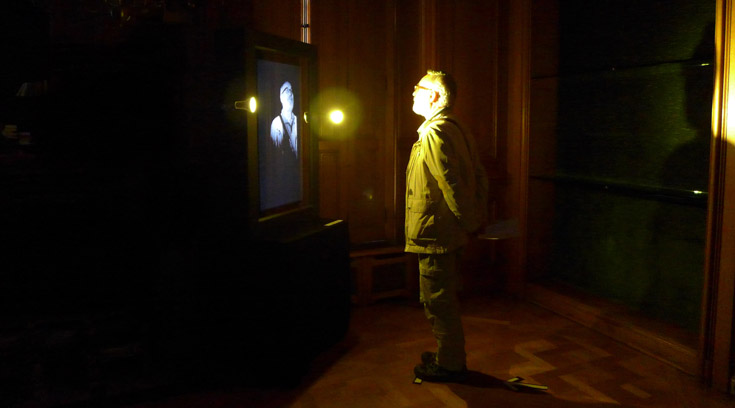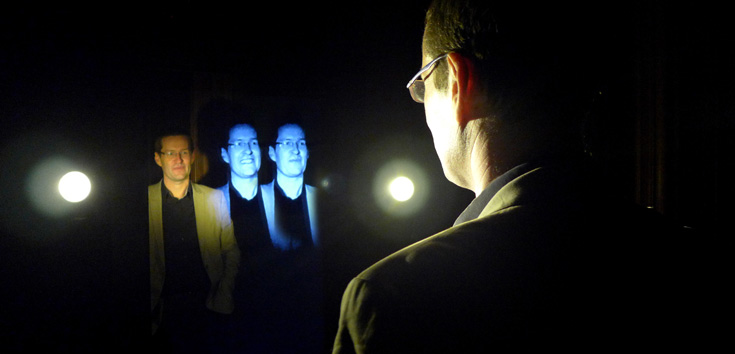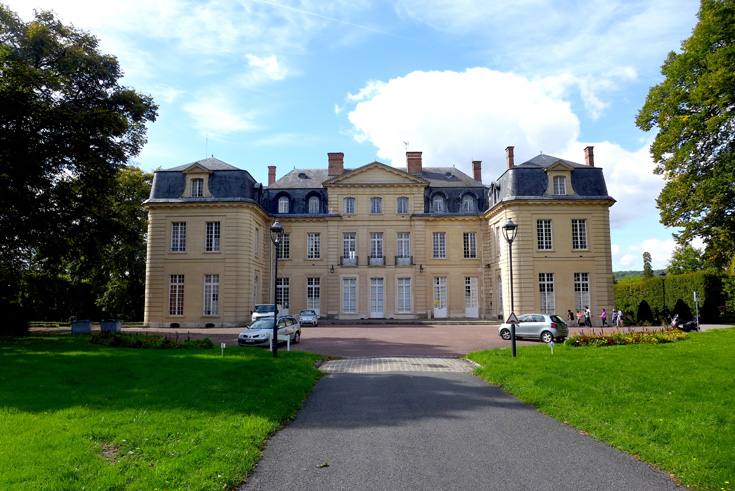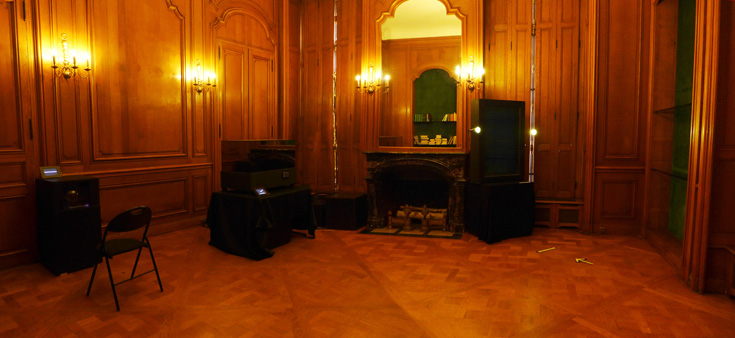FR / EN

News | Artworks | Biography | Publications | Exhibitions | Contact
Matière noire / Dark matterInteractive Installations
Scenocosme (Grégory Lasserre & Anaïs met den Ancxt)
Art & Science artworks realised with the support of La Diagonale Paris-Saclay in collaboration with the scientist :
Sébastien Descotes-Genon - Director of Laboratory of theoretical physics (CNRS & Université Paris-Sud)
 Presentation PDF + Photos
Presentation PDF + PhotosIntroduction
Since the 20th century, physicists have observed matter more and more precisely in order to discern its finest further details. In the center of the atom a nucleus is hidden, constituted with protons and neutrons, themselves made of quarks, elementary particles which are the last frontier of the infinitesimally small. Now, for the particle physicist, the question does not only consist in measuring the behavior of the basic bricks of matter, but also in explaining this behavior in a quantitative way, with numbers and equations. However, the development of these equations is an intellectual challenge. Two major breakthroughs of the 20th century must be blended in order to account for elementary particles: the theory of relativity and the quantum mechanics, each with their load of paradoxes and surprises. And their combination has generated even more disturbing consequences for the particle physicists, as they disagree strongly with our intuitive perception of the matter which surrounds us. Nuclear physics experiments, then particle physics experiments have confirmed this unexpected and disturbing vision of the mater.
It is difficult to translate this highly mathematical vision of matter into plain terms, because they rely on equations carrying concepts far way from common sense. This yields an unusual physical vision, which challenges our intuition of our everyday environment, where neither the effects of relativity nor quantum mechanics are perceptible.
We attempt at offering a different approach, more artistic, to make the spectator see, touch, experiment the matter as it is conceived by the physicists. This matter is very different from the rather mundane vision given by common sense, and full of poetic surprises.
Each artwork installation of "Dark matter" is aimed at discovering one of these confusing aspects of the matter. These artistic works reinterpret these concepts and ideas in an original form.
Support : La Diagonale Paris-Saclay : www.ladiagonale-paris-saclay.fr
Laboratoire de Physique Théorique d'Orsay ( Université Paris-Sud / CNRS) : www.th.u-psud.fr
Matière noire : Vide et matière
Dark matter : Vacuum and matter
Visual and sound interactive artwork installation
This interactive installation is a black parallelepiped. All interior and exterior surfaces reflect themselves to infinity. A hole allows to enter one's hand inside the box. Once in the volume of the glass box, the hand is covered on both sides by a visual and sound texture that reminds of the flow of particles going through our bodies at all times.
The visual vibrations shimmering at the surface of the spectator's hand evokes images of a cloud chamber. This device is used since the middle of the 20th century to detect particles.
By putting their hand into the installation, the viewers turn their hand into a particle physics detector. They will have the illusion of 'seeing' the activity due to the particles that go through him constantly, without their noticing.
The sound creation evolve with the position of the hand.
The scientific question
Our immediate notion of matter is associated to some compactness and heaviness, some resistance or impossibility against penetration. However the current view of the matter is rather a matter 'full of nothing', porous, composed of occasional particles separated by "large" distances (at the subatomic scale), a matter which it is possible to go though without difficulty. For instance, the atom is composed of electrons orbiting at a distance of ten billionth of a meter around an atomic nucleus 10 000 times smaller. The relationship between an atom and its nucleus is approximately the same ratio between the size of the Earth and the distance Earth-Sun. The matter is indeed full of... nothing.
If we are composed of particles so far from each other, it should be quite easy to go through. Indeed, we are permanently passed through by huge amounts of particles, coming from the natural radioactivity of the objects around us, but also from Sun, other stars of the Milky way or other more distant galaxies. These particles can be of many different kinds. Some are very energetic electrons or protons: most of them will be stopped by the Earth's atmosphere, sometimes creating northern lights, but some of them will reach the Earth. It could be also neutrinos, ghost particles which are capable to cross the Earth from side to side without being absorbed. The physicists have even imagined particles of a new type, called dark matter, which are not observed yet and which could go through large quantities of material without difficulty, like the neutrinos, but much heavier.
.jpg)
.jpg)
.jpg)
.jpg)
.jpg)
Matière noire : Brouillard quantique
Dark matter : Quantum fog
Visual and sound interactive artwork installation
The viewer is sitting in front of a glass sphere. He/she is invited to take the time to watch it. When he/she looks at one part of the glass sphere, a visual and sound intrinsic agitation rises in the sphere. If the viewer focuses specifically on one part of the sphere, it becomes brighter and the forms become more distinct. When he focuses an another point of the sphere, this part is lit with the same intrinsic agitation, but sometimes with a different aspect. And if the viewer looks several times at the same point on the sphere, he will realize that its aspect has changed.
This sphere allows the viewer to imagine what could be a quantum object at the human scale. The eye of the viewer provides a "measurement" that freezes, at least for a time, several characteristics of the object while others are free to fluctuate. When the viewer stops watching the sphere and measuring its characteristics, the latter start fluctuating again and become blurred. These quantum behaviors are not possible in everyday life, and they appear generally with objects at the atomic scale (or lower). At larger scales, these quantum properties disappear and the behavior is described by classical mechanics, corresponding to our day-to-day intuition.
The scientific question
We often picture matter as a solid, inert, stable object, with well-defined edges. Similarly, the most usual images of the infinitely small rely on particles as small billard balls with well-defined trajectories, which are colliding according to the laws of classical mechanics.
This image is challenged by quantum mechanics. Subatomic particles are not localized at a single point with a given speed, but are "spread" in space and in time. For instance we cannot know perfectly the location and the velocity of an electron orbiting around an atomic nucleus. And we cannot think its behavior in terms of a trajectory perfectly determined by the equations of physics. The physicist can only calculate probabilities, for example the presence of the electron in a specific point of space at any given time.
However, there are moments where this "quantum fog" stops, when the physicist performs measurements. He may then know the position of the electron (or it velocity) very precisely. But when the measure is finished, quantum mechanics comes back, and we must think again in terms of probabilities.
.jpg)
Matière noire : Les symétries discrètes
Dark matter : The discrete symmetries
Visual interactive artwork installation
The viewer is faced with a mirror that will choose randomly symmetries to apply to his reflection. These symmetries are inspired by the 3 discrete symmetries of the subatomic world:
- the parity is represented by a simple "usual" reflection, if we forget about the absence of colors (actual parity would reverse all 3 spatial components, including the top and bottom of the image).
- The reversal of the time is signified by a reflection that "goes back in the time" but accelerated (actual time reversal would keep the same rhythm of the initial movement).
- The charge conjugation is illustrated by a reflection corresponding to a negative image: it shows the passage of the matter to antimatter, complementary to each other (actual charge conjugation would create a reflection superficially identical to the original image, and the electric charge of particles should be tested in order to differentiate, say, electrons and anti-electrons).
Each "universe" shown by the mirror corresponds to an "alternative" universe, where events can be plausible or unexpected. In the same way, the symmetries of the subatomic world result in processes which are authorized on some cases, and sometimes prohibited by the physics laws.
The scientific question
In front of a particular system, the physicist needs to know what are the 'good' parameters to describe its evolution. He/she often uses a very powerful tool to identify the relevant parameters, known as "symmetries". For example, the Earth has an almost perfect spherical symmetry: in a first approximation, the gravitational force which acts on us or on satellites depends on the altitude only. It is the only relevant parameter to write the associated equations. The symmetry of rotation of the Earth allows us to simplify the problem.
Some symmetries are involved in a natural way to describe the world at human scale. It is often continuous symmetries, because we can choose "how much" we want to apply them (for example, we can choose to apply a quarter rotation, or a two-third rotation, or any other fraction). In the context of the infinitesimally small, other symmetries are also used, which are called 'discrete' and which act like a mirror, jumping from one configuration to another one without any intermediate transition. The 3 discrete symmetries used in particle physics are:
- the parity : all space coordinates are reversed, like an image obtained through three successive mirrors
- the time reversal : time is reversed, as a film played in reverse
- the charge conjugation : any particle is converted into its antiparticle, so that matter corresponds to antimatter.
If we study a physical process, such as the evolution of an electron around an atomic nucleus or the decay of a particle in lighter ones, we can look at this process through each of these 3 "mirrors". If we use one of these transformations, or two of them, the resulting image is not a physical process. This is the reason why matter and antimatter are not perfectly equivalent... and it would explain (partially) why our universe seems to have preferred matter over antimatter during its evolution from the Big Bang.
On the other hand, if we combine the 3 symmetries, the "image" process is physical and follows the same laws as the initial process. It is an important constraint to describe the behavior of elementary particles.
.jpg)
.jpg)
.jpg)



Château du CNRS de Gif-sur-Yvette / Festival Curiositas / Arts-sciences
Matière noire inside the library of the castle

Previous exhibition of Matière noire
Festival Electrochoc - Bourgoin-Jallieu (Fr)
(The festival is postpone in 2021)
Impact (International Meeting in Performing Arts and Creative Technologies) - Liège (Belgium)
Maison de la Science - Liège
Curator : Jonathan Thonon & Hervé Caps
10/11/2017 - 21/11/2017 : www.impact-regio.eu - www.maisondelascience.ulg.ac.be
Labanque / Centre de production et diffusion en arts visuels - Béthune (Fr)
Empathies - Scenocosme : Gregory Lasserre & Anais met den Ancxt
Curator : Philippe Massardier
30/03/2017 : vernissage
01/04/2017 - 23/07/2017 : www.lab-labanque.fr
Château du CNRS
Festival Curiositas / Arts-sciences - Gif-sur-Yvette (Fr)
24/09/2015 - 27/09/2015 : www.curiositas.fr
Festival Curiositas / Arts-sciences - Orsay (FR)
Musée de la lumière et de la matière Science-ACO
04/10/2014 - 06/10/2014 : www.curiositas.fr
Scenocosme : Gregory Lasserre & Anais met den Ancxt - www.scenocosme.com